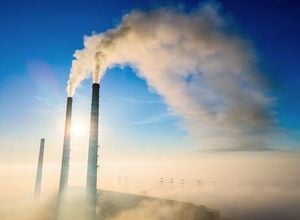When the remnants of Typhoon Halong barreled into Western Alaska on October 12, 2025, few could have predicted the scale of devastation that would follow. The storm, fueled by abnormally warm North Pacific waters, unleashed record floods and howling winds across the Yukon-Kuskokwim Delta, displacing more than 1,500 people, claiming at least one life, and leaving entire villages in tatters. As the floodwaters recede and the winds die down, the region faces a reckoning—not just with the immediate aftermath, but with profound questions about its future in an era of accelerating climate change.
The response to Halong’s fury was swift and historic. According to the Alaska National Guard, more than 600 residents were airlifted to safety in the largest evacuation operation in the state’s history. Helicopters and planes ferried evacuees first to Bethel and then on to Anchorage, where hundreds found temporary refuge in shelters at the Alaska Airlines Center and the Egan Civic and Convention Center. State officials, including Governor Mike Dunleavy, visited the hardest-hit communities—Kipnuk and Kwigillingok—to assess the damage and chart a path forward. As Dunleavy put it on October 17, “We’re in the relief process.”
But the relief process is only the beginning. The storm left behind a staggering trail of destruction: Kipnuk lost 90% of its structures, and Kwigillingok saw 35% of its buildings destroyed, according to the state Department of Transportation and Public Facilities. Napakiak, another village along the delta, had a quarter of its households displaced by flooding. In Quinhagak, the storm eroded 60 feet of shoreline, threatening to contaminate a vital salmon stream with raw wastewater and scattering centuries-old Yup’ik artifacts along the sand.
For many, the ordeal was harrowing. Missy Chuckwuk of Kipnuk, waiting to board an evacuation flight with her family, told Alaska Beacon, “We will go back, because it’s our home.” Yet the uncertainty is palpable. An estimated 50 to 100 people chose not to evacuate from Kipnuk, and 200 to 300 stayed in Kwigillingok, bracing for whatever comes next. As winter approaches, the long-term prospects for these communities hang in the balance: Will they rebuild, or will they, like the village of Newtok before them, be forced to relocate entirely?
That question looms large in light of a recent scientific study led by Torre Jorgenson, a Fairbanks-based scientist who has spent decades studying the Yukon-Kuskokwim Delta. Published in August 2025, the study paints a grim picture of the region’s future. Intertwined climate change forces—coastal erosion, permafrost thaw, sea-level rise, and saltwater intrusion—are converging to transform the delta. Jorgenson’s research concludes that of the 18 villages on the delta’s outer coast, at least 10 will likely need to relocate within the next two to three decades as permafrost disappears. “So the ground is going down, and the water is coming up, and they’ll be unlivable,” Jorgenson told Alaska Beacon. The cost of such relocations? Potentially hundreds of millions of dollars per village.
The challenges are daunting. The permafrost that once provided a stable foundation for homes and infrastructure is thawing at an alarming rate, a process accelerated by storm surges and saltwater intrusion. As Jorgenson explained, saltwater kills tundra plants that act as natural insulation, allowing more heat to penetrate and further thaw the ground. By the end of this century, he projects, the Bering Sea’s ice-free season will last about 8.5 months, with ice forming two months later in the fall and melting a month earlier in the spring. Residents already experienced a preview in 2018, when winter ice was scarcer than at any point in the past 150 years.
These environmental changes go beyond damaged homes—they threaten the very fabric of Indigenous life. Traditional hunting camps, food-gathering areas, and even drinking water supplies are at risk. Earlier sea ice melt exposes the coast to more flooding during the critical spring nesting season for migratory birds, a key source of eggs and meat for the Yup’ik people. As Jorgenson noted, “Beyond damaging homes and villages, the changes hurt people’s ability to gather wild food in their traditional ways.”
The origins of Typhoon Halong, and the similarly destructive Typhoon Merbok in 2022, can be traced to the warming North Pacific Ocean. Rick Thoman, a scientist at the University of Alaska Fairbanks, explained to Alaska Beacon, “Passing over near or at-record warm sea surface temperatures outside of the tropics, that’s something that both of those storms have in common.” Such conditions, he warned, are likely to become more frequent.
Local leaders have sounded the alarm. At the Alaska Federation of Natives convention on October 16 and 17, co-chair Ana Hoffman addressed the hundreds of Yup’ik evacuees: “You were at the forefront of this recent storm and endured what is now becoming a new reality here: typhoons in the Arctic.” Mike Williams Sr., a tribal leader from Akiak, echoed these concerns: “We’re not going to be well. Storms are going to get worse, and it’s not going to be livable. We’re past the tipping point, maybe.”
Yet, as the region grapples with disaster, federal support has become a political flashpoint. The Trump administration recently canceled several grants awarded during the Biden administration for projects like coastal erosion control, permafrost protection, and renewable energy development. Kipnuk, one of the hardest-hit villages, lost a $20 million grant meant to protect against exactly this kind of disaster. EPA Administrator Lee Zelden dismissed the funds as “wasteful DEI and Environmental Justice grants,” while EPA press secretary Brigit Hirsch argued, “The ‘environmental justice’ funding cancelled by EPA would not have prevented or safeguarded the community from the mass destruction and tragedy caused by such a large and devastating typhoon.”
Compounding the problem, cuts to weather monitoring and disaster prevention programs have hampered the state’s ability to predict and respond to storms. Rick Thoman pointed out that reductions in rural Alaska weather staff and balloon launches meant forecasts for Halong were less accurate than those for Merbok in 2022. The Government Accountability Office has flagged the shortage of meteorologists as a serious risk, particularly for aviation safety. Similarly, FEMA’s capacity to respond to disasters has been undermined by staffing cuts, with the agency losing about a tenth of its workforce in recent years.
In the immediate term, the state is leading the disaster response. Governor Dunleavy formally requested a presidential disaster declaration for the Yukon-Kuskokwim area and northwestern Alaska on October 16, seeking federal aid to help with recovery and to cover 100% of costs for the first 90 days. As of October 17, FEMA said the declaration was “under review,” with responses potentially delayed by the ongoing federal government shutdown.
Meanwhile, the transition from congregate shelters to temporary housing is underway. Anchorage officials have identified 1,000 hotel rooms and 100 apartments for evacuees, but with winter fast approaching, the clock is ticking. “Hopefully over the next few weeks, we’ll have a much better understanding about how many people can go back to the villages, and then long term discussions as to, what is this going to look like over the long term?” Dunleavy said. For now, survivors are encouraged to apply for state assistance to help with housing and repairs, as the region begins the long, uncertain road to recovery.
As the people of the Yukon-Kuskokwim Delta face the dual threats of climate change and political gridlock, their resilience is being tested like never before. Whether these ancient communities can endure—or must seek new homes elsewhere—remains an open question, but one thing is clear: the stakes have never been higher.






